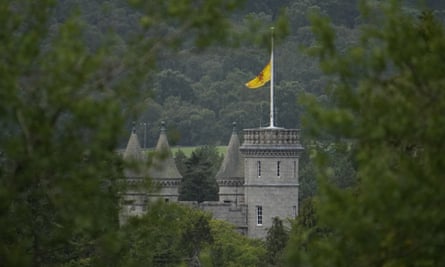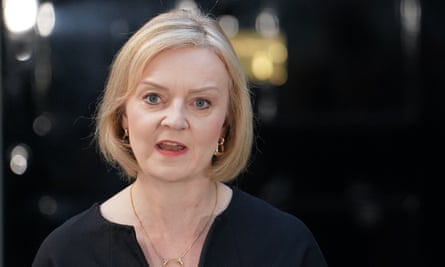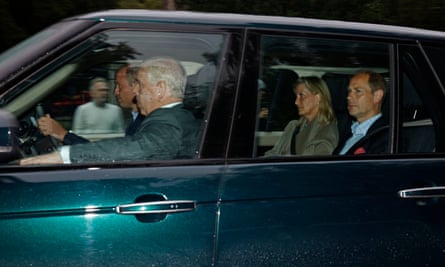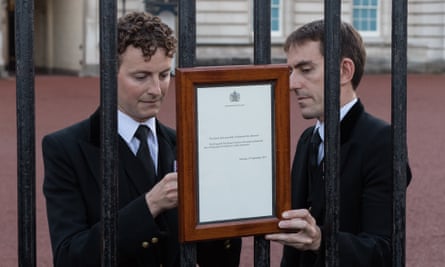Plans in the event of Queen Elizabeth II’s death were meticulous; they were revisited and updated regularly. On 8 September, they were executed flawlessly. But not everything could be anticipated.
Balmoral Castle, despite its grand, gothic revivalist exterior, is intimate compared with Buckingham Palace and Windsor Castle, which is one of the reasons the late queen loved it. Its private quarters and official offices are quite close together.
So on the morning of 8 September, few, if any, at Balmoral would have been unaware of the momentous events unfolding as the queen’s life quietly ebbed.
Two days previously, leaning heavily on a stick but with that familiar smile in place, she had appointed her 15th and final British prime minister, Liz Truss. But an announcement just after 6pm the following evening, that the queen was postponing a virtual privy council meeting on the advice of doctors, was concerning.
The imminent death of a sovereign is a major constitutional matter. No 10 would have been alerted immediately about her deteriorating condition. Simon Case, the cabinet secretary, and Sir Edward Young, the queen’s private secretary, would serve as the pivotal liaison between the palace and Downing Street.

That evening, Case was informed, and passed the message on to Truss, that there was the distinct possibility the queen’s condition might worsen rapidly. As Truss worked late on the energy statement, her first major act as prime minister, she had in the back of her mind the fact it might all be overshadowed, according to sources.
If any of the staff at Windsor were uncertain of how serious the situation was, the departure of the queen’s helicopter from Windsor Castle shortly before 7am to take the Prince of Wales from Dumfries House in Ayrshire, where he was staying that night, to his mother’s bedside, would have alerted them.
Charles arrived at Balmoral shortly before 10.30am, and the Duchess of Cornwall was driven from nearby Birkhall to join him. The Princess Royal, in Scotland on engagements, was already there.
In No 10, Case was categorical that bad news was on its way, perhaps in a matter of hours. Truss had still not packed all her clothes for her move into Downing Street and, according to the biography Out of the Blue, aides were sent to her Greenwich home to locate black clothing.

Truss was also still mid-reshuffle when the palace started to inform key people in government through its planned “cascade” system. One minister said they walked into their new department to be told without any ceremony: “You have a meeting in 30 minutes.” Officials said in direct language that they expected the queen’s death was imminent and that the first job of the minister would be an immediate briefing on the so-called London Bridge plans.
“That was like a baptism of fire for me,” the minister recalled. “I didn’t back Liz, I was expecting to be on the backbenches. So not only was I thinking about moving departments, taking a job that was very new to me, but within minutes I was part of one of the most high-profile operations on Earth.”
Indications to the general public that something was wrong came in a place where the queen is almost never mentioned – the House of Commons. Truss had finished her opening remarks and was listening to Sir Keir Starmer. The new chancellor of the duchy of Lancaster, Nadhim Zahawi, slipped into the chamber and inserted himself between Kwasi Kwarteng and Truss to speak to the prime minister, handed her a note, then slipped out again. MPs picked up the frisson almost immediately, beginning to whisper among themselves.

The next person to be told was Labour’s deputy leader, Angela Rayner, who read a note passed from outside the chamber, which she handed to the shadow chancellor, Rachel Reeves, who also looked at it grim-faced.
The note was in plain English – with no codes about “London Bridge”. It said: “The queen is unwell, and Keir needs to leave the chamber as soon as possible to be briefed.” Rayner tried not to be “too dramatic” in handing the note to Starmer, she has since said, torn by a desire not to distract him mid-flow while also realising the urgency of the situation. She then saw the speaker, Sir Lindsay Hoyle, gesticulating, suggesting she should interrupt the Labour leader regardless.
At 12.32pm a statement was released from Buckingham Palace: “The queen’s doctors are concerned for Her Majesty’s health and have recommended she remain under medical supervision. The queen remains comfortable and at Balmoral.”
The BBC’s Huw Edwards, dressed in black tie, announced the news to the general public. An evening call from Truss to the French president, Emmanuel Macron, was cancelled.
For the queen’s family members not already at Balmoral and unable to know how swiftly she would deteriorate, it would have been a difficult call: head there too early and risk spreading alarm; too late, and miss the opportunity to say goodbye.
after newsletter promotion
When Buckingham Palace announced at 12.50pm that William, Andrew, Edward and Sophie were on their way to Scotland, the gravity of situation was very clear. At about 2pm, in a separate statement, the Sussexes, who were staying at Frogmore Cottage on a visit to the UK to attend an awards ceremony, announced that they, too, would be heading to Scotland.

Two hours later, when it became clear that Kate was remaining at the Cambridges’ new Windsor home, where the couple’s three children were still settling in to the school they had started at three days previously, plans for Meghan to accompany Harry appeared to have been dropped.
There has been much speculation over why Harry did not accompany his brother and uncles onboard the jet that left RAF Northolt at 2.40pm. There have been suggestions the flight was originally intended to depart at 1.30pm. If that was the case, no reason has been given for the delay.
In any event, Harry would travel separately, leaving Luton airport onboard a private jet at about 5.30pm. He would still be in the air when the announcement of the queen’s death was made at 6.30pm.
It would later transpire, when her death certificate was made public weeks later, that the queen died at 3.10pm. She was pronounced deceased – the cause of death later given as “old age” – by Dr Douglas Glass, her official apothecary in Scotland, who holds GP clinics for Balmoral staff. He has since said there was concern for the queen’s health for several months: “It was expected and we were quite aware of what was going to happen,” he is quoted as saying in Gyles Brandreth’s new biography, Elizabeth: An Intimate Portrait.
William and the other royals landed at Aberdeen airport at 3.50pm, 40 minutes after her death. With William at the wheel, they drove to Balmoral, arriving at 5.06pm, an hour and 25 minutes before the news would be made public.
By then, the official cascading of the news was in full swing. An internal palace team was calling all those who needed to be informed as soon as possible: No 10, Lambeth Palace, the chief of the defence staff, prime ministers and high commissioners of the 14 other countries of which she was head of state, to name but a few.

By the time Harry landed at Aberdeen airport at 6.45pm, the world knew. Buckingham Palace has since denied reports that Charles or his aides were unable to contact his second son ahead of the public announcement. “The public was only informed after every family member had been informed,” the new king’s spokesperson said at the time.
Harry finally arrived at Balmoral at 7.52pm. By then, Charles had released his own personal tribute to the late monarch, mother, grandmother and great-grandmother.
Outside No 10, the podium was put in place. Truss, in the black clothes her aides had managed to locate for her, stepped up to it at 7.07pm. It was, she said, “the passing of the second Elizabethan age”.
It was the end, too, of a truly historic day.
